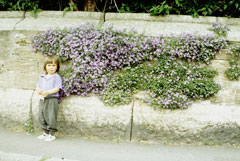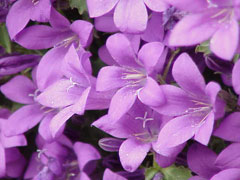 |
|
(c) 2010 Ken Fern & Plants For A Future |
 |
| http://www.biolib.de/ |
Translate this page:
Summary
Physical Characteristics

 Campanula portenschlagiana is an evergreen Perennial growing to 0.3 m (1ft) by 1 m (3ft 3in) at a fast rate.
Campanula portenschlagiana is an evergreen Perennial growing to 0.3 m (1ft) by 1 m (3ft 3in) at a fast rate.
See above for USDA hardiness. It is hardy to UK zone 3 and is not frost tender. It is in leaf all year, in flower from July to September. The species is hermaphrodite (has both male and female organs) and is pollinated by Bees, flies, beetles, Lepidoptera (Moths & Butterflies). The plant is self-fertile.
Suitable for: light (sandy) and medium (loamy) soils, prefers well-drained soil and can grow in nutritionally poor soil. Suitable pH: neutral and basic (mildly alkaline) soils. It can grow in semi-shade (light woodland) or no shade. It prefers moist soil.
UK Hardiness Map
US Hardiness Map
Synonyms
C. muralis. Portenschl.
Plant Habitats
Woodland Garden Dappled Shade; Ground Cover; East Wall. In. South Wall. In. West Wall. In.
Edible Uses
Edible Parts: Flowers Leaves
Edible Uses:
Leaves - raw or cooked[K]. The leaves are rather small, but they are produced all year round[K]. They have a mild flavour and make an acceptable ingredient in mixed salads, especially in the winter, but we find that, eaten in quantity, they become a bit unpleasant[K]. Flowers - raw. Very freely produced, they have a pleasant flavour and make a very decorative addition to salads[K].
References More on Edible Uses
Medicinal Uses
Plants For A Future can not take any responsibility for any adverse effects from the use of plants. Always seek advice from a professional before using a plant medicinally.
None known
References More on Medicinal Uses
The Bookshop: Edible Plant Books
Our Latest books on Perennial Plants For Food Forests and Permaculture Gardens in paperback or digital formats.

Edible Tropical Plants
Food Forest Plants for Hotter Conditions: 250+ Plants For Tropical Food Forests & Permaculture Gardens.
More

Edible Temperate Plants
Plants for Your Food Forest: 500 Plants for Temperate Food Forests & Permaculture Gardens.
More

More Books
PFAF have eight books available in paperback and digital formats. Browse the shop for more information.
Shop Now
Other Uses
A rampantly spreading plant, suitable for ground cover in a sunny position[197, 208].
Special Uses
Food Forest Ground cover
References More on Other Uses
Cultivation details
Prefers a moist but well-drained rich sandy loam and a neutral or alkaline soil preferring full sun but also succeeding in partial shade[1, 200, 208]. This species prefers a slightly shaded position[221]. Plants can be grown on a dry stone wall[200] and succeed in poor soils[221]. Plants are hardy to at least -15°c[200]. The species in this genus do not often hybridize and so seed can generally be relied upon to come true[221]. The plants are self-fertile[221]. A rampant plant, capable of spreading widely when in suitable conditions by means of both underground roots and long stems above ground [188, 271]. It makes a good ground cover but can become a nuisance if it is not sited with care[200]. It is, however, fairly easy to control by simply pulling up any parts of the plant that wander too far[271]. There are several named forms selected for their ornamental value[200]. Members of this genus are rarely if ever troubled by browsing deer[233]. The plant is heat tolerant in zones 7 through 1. (Plant Hardiness Zones show how well plants withstand cold winter temperatures.
Plant Heat Zones show when plants would start suffering from the heat.
The Plant Heat Zone map is based on the number of "heat days" experienced in a given area where the temperature climbs to over 86 degrees F (30°C).
At this temperature, many plants begin to suffer physiological damage. Heat Zones range from 1 (no heat days) to 12 (210 or more heat days).
For example Heat Zone. 11-1 indicates that the plant is heat tolerant in zones 11 through 1.) For polyculture design as well as the above-ground architecture (form - tree, shrub etc. and size shown above) information on the habit and root pattern is also useful and given here if available. The plant growth habit is a runner spreading indefinitely by rhizomes or stolons [1-2].
References Carbon Farming Information and Carbon Sequestration Information
Temperature Converter
Type a value in the Celsius field to convert the value to Fahrenheit:
Fahrenheit:
The PFAF Bookshop
Plants For A Future have a number of books available in paperback and digital form. Book titles include Edible Plants, Edible Perennials, Edible Trees,Edible Shrubs, Woodland Gardening, and Temperate Food Forest Plants. Our new book is Food Forest Plants For Hotter Conditions (Tropical and Sub-Tropical).
Shop Now
Plant Propagation
Seed - surface sow spring in a cold frame. The seed usually germinates in 2 - 4 weeks at 18°c[138]. When they are large enough to handle, prick the seedlings out into individual pots and grow them on in a cold frame for at least their first winter. Plant them out into their permanent positions in late spring or early summer, after the last expected frosts. Basal cuttings in spring[1]. Harvest the shoots when they are about 10 - 15cm long with plenty of underground stem. Pot them up into individual pots and keep them in light shade in a cold frame or greenhouse until they are rooting well. Plant them out in the summer. Division in spring or autumn[200]. Very easy, the plant can be divided at almost any time of the year[221].
Other Names
If available other names are mentioned here
Native Range
EUROPE: Bosnia and Herzegovina, Croatia, Montenegro,
Weed Potential
Right plant wrong place. We are currently updating this section.
Please note that a plant may be invasive in one area but may not in your area so it’s worth checking.
Conservation Status
IUCN Red List of Threatened Plants Status :

| Related Plants
|
| Latin Name | Common Name | Habit | Height | Hardiness | Growth | Soil | Shade | Moisture | Edible | Medicinal | Other |
| Adenophora denticulata | | Perennial | 0.5 |
6-9
| | LM | N | M | 2 | 0 | |
| Adenophora divaricata | | Perennial | 1.0 |
-
| | LM | N | M | 2 | 0 | |
| Adenophora lamarkii | | Perennial | 0.6 |
5-9
| | LM | N | M | 2 | 0 | |
| Adenophora latifolia | | Perennial | 0.5 |
-
| | LM | N | M | 2 | 0 | |
| Adenophora liliifolia | Ladybells, Lilyleaf | Perennial | 0.5 |
3-8
| M | LM | N | M | 2 | 0 | |
| Adenophora nikoensis | | Perennial | 0.3 |
5-9
| | LM | N | M | 2 | 0 | |
| Adenophora remotiflora | | Perennial | 1.0 |
5-9
| | LM | N | M | 2 | 1 | |
| Adenophora stricta | Sha Shen, Ladybells | Perennial | 1.0 |
7-9
| | LM | N | M | 2 | 1 | |
| Adenophora triphylla | Nan Sha Shen | Perennial | 1.0 |
6-9
| | LM | N | M | 2 | 1 | |
| Adenophora verticillata | | Perennial | 1.0 |
6-9
| | LM | SN | M | 2 | 2 | |
| Agapanthus campanulatus | | Bulb | 0.6 |
6-9
| | LM | SN | M | 0 | 1 | |
| Asyneuma pulchellum | | Perennial | 0.0 |
-
| | LMH | SN | M | 0 | 0 | 2 |
| Asyneuma salignum | | Perennial | 0.0 |
-
| | LMH | SN | M | 0 | 0 | 2 |
| Azorina vidalii | | Shrub | 0.3 |
8-11
| | LM | N | DM | 3 | 0 | 0 |
| Campanula alliariifolia | Cornish Bellflower | Perennial | 0.7 |
3-7
| M | LM | SN | M | 3 | 0 | 3 |
| Campanula carpatica | Tussock Bellflower, Carpathian Bellflower, Carpathian Harebell | Perennial | 0.3 |
3-8
| S | LM | SN | M | 3 | 0 | 2 |
| Campanula carpatica turbinata | | Perennial | 0.3 |
3-7
| | LM | N | M | 3 | 0 | 2 |
| Campanula cochleariifolia | Fairies Thimbles | Perennial | 0.2 |
5-9
| | LM | N | M | 4 | 0 | |
| Campanula edulis | | Perennial | 0.2 |
-
| | LM | SN | M | 2 | 0 | |
| Campanula fenestrellata | Adriatic Bellflower | Perennial | 0.2 |
5-9
| M | LM | SN | M | 4 | 0 | |
| Campanula garganica | Adriatic Bellflower | Perennial | 0.2 |
4-8
| | LM | N | M | 3 | 0 | |
| Campanula glomerata | Clustered Bellflower, Dane's blood, Clustered Bellflower | Perennial | 1.0 |
4-9
| M | LM | SN | M | 4 | 0 | |
| Campanula lactiflora | Milky Bellflower | Perennial | 1.0 |
4-8
| | LM | SN | M | 3 | 0 | |
| Campanula lasiocarpa | Mountain harebell | Perennial | 0.2 |
4-8
| | L | N | M | 2 | 0 | |
| Campanula latifolia | Large Campanula, Giant bellflower | Perennial | 1.5 |
3-7
| | LM | FS | DM | 3 | 1 | |
| Campanula latiloba | | Perennial | 0.9 |
3-7
| M | LM | SN | M | 3 | 0 | 3 |
| Campanula medium | Canterbury Bells, Cup and Saucer, Canterbury Bells | Biennial | 1.2 |
6-8
| M | LM | SN | M | 2 | 0 | 1 |
| Campanula parryi | Parry's Bellflower, Idaho bellflower | Perennial | 0.3 |
4-8
| F | LM | SN | M | 1 | 1 | 1 |
| Campanula persicifolia | Harebell, Peachleaf bellflower | Perennial | 1.0 |
3-7
| | LM | SN | M | 4 | 0 | |
|
|
Growth: S = slow M = medium F = fast. Soil: L = light (sandy) M = medium H = heavy (clay). pH: A = acid N = neutral B = basic (alkaline). Shade: F = full shade S = semi-shade N = no shade. Moisture: D = dry M = Moist We = wet Wa = water.
Expert comment
Author
Schult.
Botanical References
200
Links / References
For a list of references used on this page please go here
Readers comment
| Add a comment |
|
If you have important information about this plant that may help other users please add a comment or link below. Only comments or links that are felt to be directly relevant to a plant will be included. If you think a comment/link or information contained on this page is inaccurate or misleading we would welcome your feedback at [email protected]. If you have questions about a plant please use the Forum on this website as we do not have the resources to answer questions ourselves.
* Please note: the comments by website users are not necessarily those held by PFAF and may give misleading or inaccurate information.
To leave a comment please Register or login here All comments need to be approved so will not appear immediately.
|
Subject : Campanula portenschlagiana
|
|
|
|